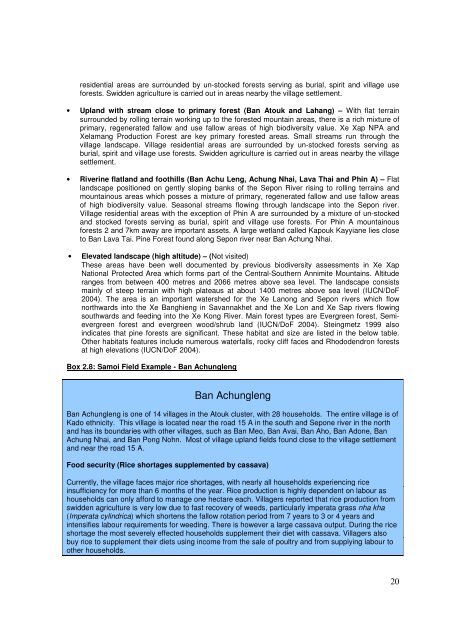Part 1 – A Rapid Participatory Biodiversity Assessment - IUCN
Part 1 – A Rapid Participatory Biodiversity Assessment - IUCN
Part 1 – A Rapid Participatory Biodiversity Assessment - IUCN
Create successful ePaper yourself
Turn your PDF publications into a flip-book with our unique Google optimized e-Paper software.
esidential areas are surrounded by un-stocked forests serving as burial, spirit and village use<br />
forests. Swidden agriculture is carried out in areas nearby the village settlement.<br />
• Upland with stream close to primary forest (Ban Atouk and Lahang) <strong>–</strong> With flat terrain<br />
surrounded by rolling terrain working up to the forested mountain areas, there is a rich mixture of<br />
primary, regenerated fallow and use fallow areas of high biodiversity value. Xe Xap NPA and<br />
Xelamang Production Forest are key primary forested areas. Small streams run through the<br />
village landscape. Village residential areas are surrounded by un-stocked forests serving as<br />
burial, spirit and village use forests. Swidden agriculture is carried out in areas nearby the village<br />
settlement.<br />
• Riverine flatland and foothills (Ban Achu Leng, Achung Nhai, Lava Thai and Phin A) <strong>–</strong> Flat<br />
landscape positioned on gently sloping banks of the Sepon River rising to rolling terrains and<br />
mountainous areas which posses a mixture of primary, regenerated fallow and use fallow areas<br />
of high biodiversity value. Seasonal streams flowing through landscape into the Sepon river.<br />
Village residential areas with the exception of Phin A are surrounded by a mixture of un-stocked<br />
and stocked forests serving as burial, spirit and village use forests. For Phin A mountainous<br />
forests 2 and 7km away are important assets. A large wetland called Kapouk Kayyiane lies close<br />
to Ban Lava Tai. Pine Forest found along Sepon river near Ban Achung Nhai.<br />
• Elevated landscape (high altitude) <strong>–</strong> (Not visited)<br />
These areas have been well documented by previous biodiversity assessments in Xe Xap<br />
National Protected Area which forms part of the Central-Southern Annimite Mountains. Altitude<br />
ranges from between 400 metres and 2066 metres above sea level. The landscape consists<br />
mainly of steep terrain with high plateaus at about 1400 metres above sea level (<strong>IUCN</strong>/DoF<br />
2004). The area is an important watershed for the Xe Lanong and Sepon rivers which flow<br />
northwards into the Xe Banghieng in Savannakhet and the Xe Lon and Xe Sap rivers flowing<br />
southwards and feeding into the Xe Kong River. Main forest types are Evergreen forest, Semievergreen<br />
forest and evergreen wood/shrub land (<strong>IUCN</strong>/DoF 2004). Steingmetz 1999 also<br />
indicates that pine forests are significant. These habitat and size are listed in the below table.<br />
Other habitats features include numerous waterfalls, rocky cliff faces and Rhododendron forests<br />
at high elevations (<strong>IUCN</strong>/DoF 2004).<br />
Box 2.8: Samoi Field Example - Ban Achungleng<br />
Ban Achungleng<br />
Ban Achungleng is one of 14 villages in the Atouk cluster, with 28 households. The entire village is of<br />
Kado ethnicity. This village is located near the road 15 A in the south and Sepone river in the north<br />
and has its boundaries with other villages, such as Ban Meo, Ban Avai, Ban Aho, Ban Adone, Ban<br />
Achung Nhai, and Ban Pong Nohn. Most of village upland fields found close to the village settlement<br />
and near the road 15 A.<br />
Food security (Rice shortages supplemented by cassava)<br />
Currently, the village faces major rice shortages, with nearly all households experiencing rice<br />
insufficiency for more than 6 months of the year. Rice production is highly dependent on labour as<br />
households can only afford to manage one hectare each. Villagers reported that rice production from<br />
swidden agriculture is very low due to fast recovery of weeds, particularly imperata grass nha kha<br />
(Imperata cylindrica) which shortens the fallow rotation period from 7 years to 3 or 4 years and<br />
intensifies labour requirements for weeding. There is however a large cassava output. During the rice<br />
shortage the most severely effected households supplement their diet with cassava. Villagers also<br />
buy rice to supplement their diets using income from the sale of poultry and from supplying labour to<br />
other households.<br />
20

















